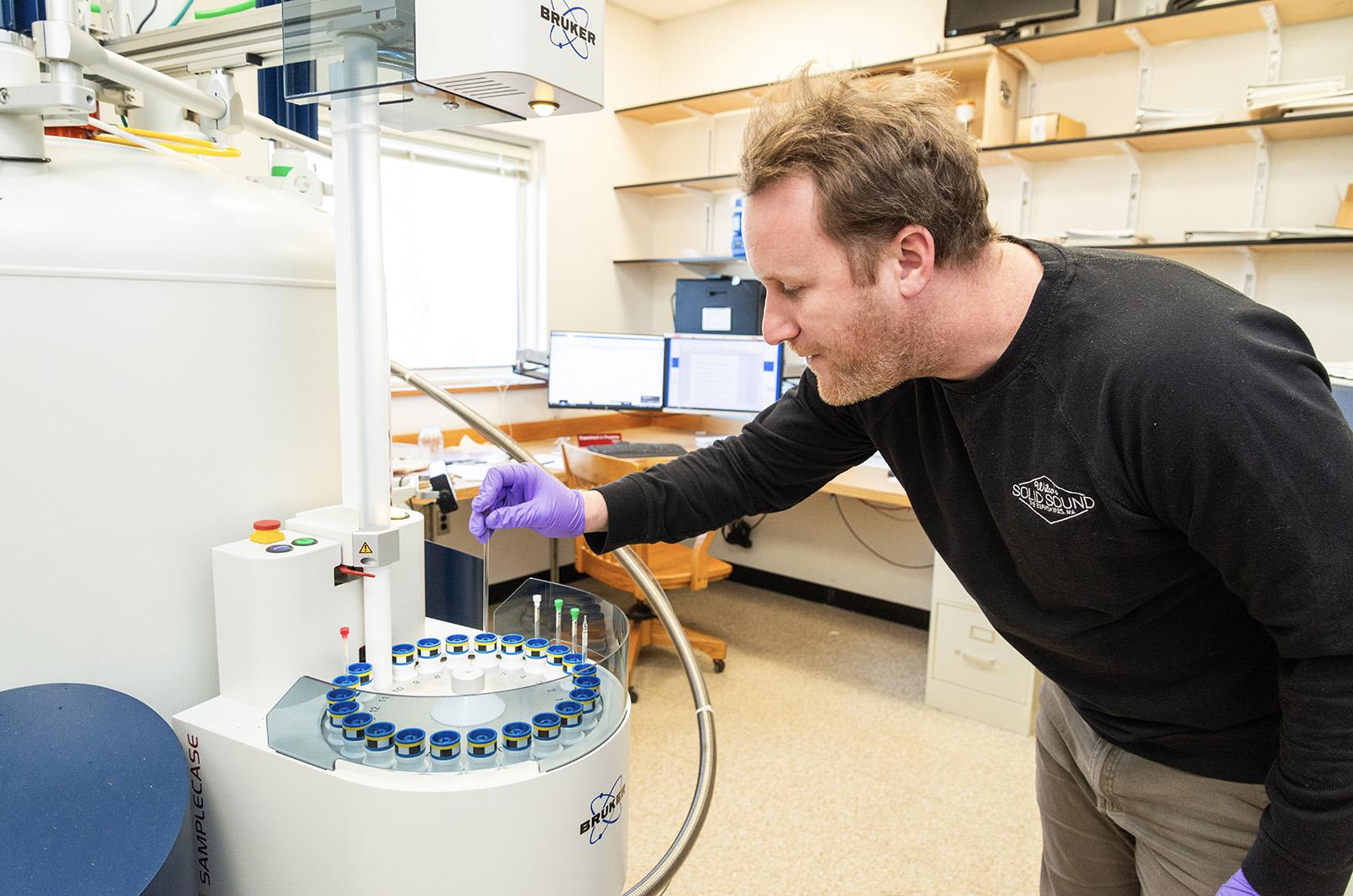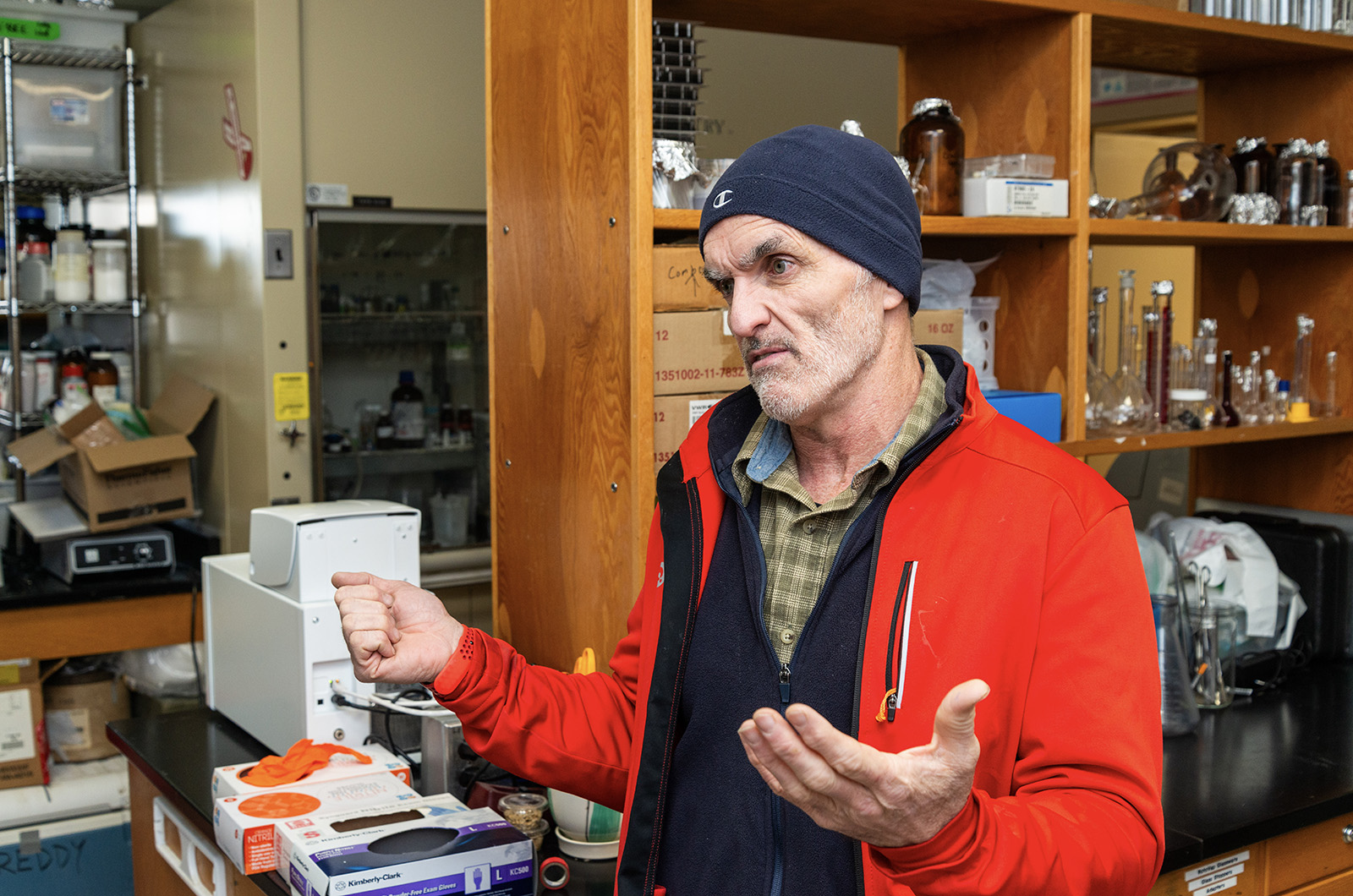Just across Vineyard Sound in a laboratory near the shore, environmental chemist Collin Ward monitors four shallow tubs flowing with ocean water. To the naked eye, the water appears clear. But beneath the ripples are samples of the world’s most pervasive pollutant of marine ecosystems: microplastics.
Mr. Ward is studying how the plastic particles, which are in every one of the Earth’s oceans, biodegrade when submerged in a variety of water temperatures. He is one of several scientists at the Woods Hole Oceanographic Institution (WHOI) researching the behaviors of the toxic debris as part of the organization’s initiative to curb plastic pollution.
“With these [tubs] we can measure the degradation of the plastic over time, document how the physical properties of the plastic change and see which microbes are degrading the plastic,” said Mr. Ward. “The water gets pumped straight from the ocean . . . We’re trying to mimic the normal environment as best as possible.”
First discovered in the open ocean in the 1970s, microplastics are fragments of synthetic polymer material smaller than five millimeters long. Some, known as primary microplastics or microbeads, are common ingredients in health and cosmetic products such as toothpaste, sunscreen and face wash. Others, called secondary microplastics, are from larger plastic products that have broken down over time from environmental exposures.
Each year, millions of tons of microplastics enter the planet’s waterways, infiltrating the bodies of marine life and contaminating drinking water. They can contain heavy metals and other harsh chemicals — the long-term health effects of which are still largely unknown.
By studying how the particles react to various environmental factors, Mr. Ward hopes to determine how long microplastics can persist in the natural world and, ultimately, how to inform the creation of a plastic product that is environmentally sound.
“[Microplastics is] one of the fastest-moving sort of sub-disciplines that science has right now,” said Mr. Ward. “Sometimes we’re really thinking about what’s happening to all of the plastics that are out there, and other times we’re focusing more on designing new plastics to accommodate a quicker breakdown process.”
Mr. Ward began working at WHOI in 2016 as a postdoctoral scientist researching the aftermath of the 2010 Deepwater Horizon oil spill in the Gulf of Mexico. He partnered with longtime WHOI senior scientist Christopher Reddy who, in addition to his fascination with oil pollution, was becoming increasingly curious about microplastics, a topic that was beginning to regularly hit mainstream news.
In 2017, Mr. Reddy, Mr. Ward and several other plastic-oriented scientists and engineers formed Microplastics @ WHOI, an interdisciplinary division dedicated to demystifying microplastics.
“We’re really lucky because most universities or institutions in the U.S. might have, you know, one or two pollutant scientists,” said Mr. Reddy. “But at WHOI, because we have a lot of different kinds of people interested in our primary interest of oceanography, it makes for great synergy. We have chemists, toxicologists, microbiologists, engineers — you name it.”
An average day in the lab is not particularly thrilling, said Mr. Reddy, who spends much of his time at his computer writing emails or scientific papers and reading up on the latest microplastic studies.
But when an environmental catastrophe strikes, he and his colleagues spring into action.
In May 2021, a cargo ship off the west coast of Sri Lanka carrying hundreds of tons of bunker oil and over 70 billion plastic pellets caught fire, causing the largest marine plastic spill in world history. Mr. Reddy was shipped a Ziploc bag of pellets for examination, and within the week, he and his cohort sent a fact sheet back to Sri Lanka, detailing the ins and outs of the contaminants.
“We found that the burnt pellets were much more toxic than those that weren’t,” said Mr. Reddy. “People were still out there cleaning up the spill, they were in the middle of monsoon season, [Covid] vaccinations hadn’t really showed up yet, the burning ship was creating an air quality problem and then come to find out these burnt pellets had a significant load of carcinogens.”
Mr. Reddy is now studying pellets that were collected from the spill site six months after the disaster. The goal, he said, is to continue to track how the plastics change with different lengths of oceanic exposure.
“Often when we find microplastics, we don’t know exactly where they came from,” said Mr. Reddy. “But this is a unique situation where we do know their origins, and we can track them and try to tell a story.”
In Mr. Reddy’s personal life, the line between environmental scientist and environmentalist can be blurry. He tries not to generate plastic waste, but knows that avoiding the material altogether is nearly impossible and expecting consumers to do so is unreasonable.
The enemy, he said, is the piece of plastic — not the person using it.
For Mr. Ward, his microplastic research serves as a reminder to check his family’s consumption of material goods, plastic or not.
“It really makes me appreciate the scope and scale of this problem, and really how much we all consume,” he said. “It’s an opportunity to reflect on how much we actually need. Like, do I really need to keep buying all of this stuff and throwing it in a landfill? I don’t. I think that’s all starting to catch up to us.”
Still, Mr. Reddy and Mr. Ward are optimistic about the oceans’ plastic problem. The key, they agreed, is a new generation of plastic or plastic-like product that is both durable and easily biodegradable.
“Chemists are really victims of their own success,” said Mr. Reddy. “They over-engineered the design and made something that lasts a little too long. So now we’re looking to design a plastic without harmful materials that still gets the job done.”









Comments (6)
Comments
Comment policy »